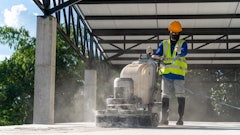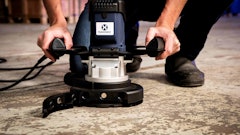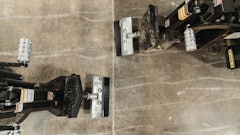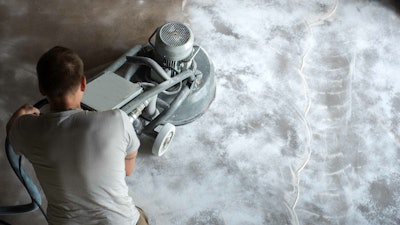
Coating a concrete floor requires an accurate diagnosis of the floor before application. You, the installer, and your client will be much happier with the result when surface preparation methods are followed, but conducting a proper physical inspection is critical before you install a coating system. There is quite a bit of opinion and advice, answers, and proven concepts to follow on floor coating installation, but here, we are focusing on the proper prescription for coating a floor.
An instructor in a coatings class will not say, “All you have to do is this...” Coating concrete is a process, and no steps can be skipped, no corners can be cut, and if you don’t have hawk-like attention to detail, find someone to assist your team. Even if a floor coatings installer does everything right, that bird living in the rafters can die flapping its wings in your wet coating, or the neighbor’s puppy can run playfully through the fresh epoxy and trot all over the pristine driveway with sticky paws.
A Distinct Prescription for Coating Concrete
In many ways, coating concrete is like being a doctor and having to prescribe the right medicine or corrective treatment to achieve a successful long-lasting outcome. When you visit a doctor for a routine check-up or illness, they follow the same protocols and checklists taught in medical school. They check your temperature, vital signs, blood pressure, heart rate, breathing, ears, nose, throat, and generally want to make sure all the important body functions are somewhat normal. If you are healthy, instructions to keep your good health are advised. If you are wounded or ill, the proper steps to heal you are recommended.
Approach surface preparation using checklists just like a medical doctor, and then you are prescribing the right solution. Remember too, that a doctor has four extra years of medical school and eight years of residency before being qualified to serve as a doctor. There is no substitute for experience with coating concrete, and it’s advisable to learn from a mentor, and read and study it. 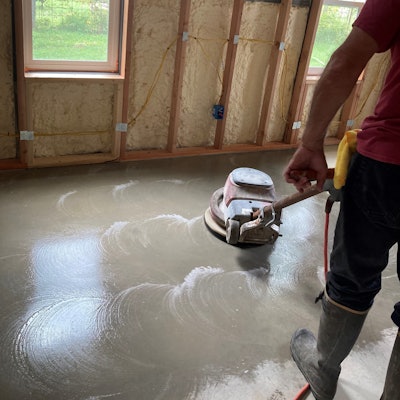 Like a doctor, first figure out your “patient” or your “category of concrete” that you are about to cover with a coating system before beginning a job.Coval Technologies
Like a doctor, first figure out your “patient” or your “category of concrete” that you are about to cover with a coating system before beginning a job.Coval Technologies
Step 1) Inspect & Diagnose
An acquaintance of mine once said, “Concrete is not a product, it is a category.” Every piece of concrete formed, poured, and finished is different from the next because it is impossible to recreate the exact conditions each time like you can in a manufacturing facility. Concrete can be new or old, hard, soft, different quantities of ingredients, hard troweled, hand troweled, broom finished, or have a release agent or curing compound installed.
The weather conditions during the placement of the concrete can change the outcomes. A floor could have been previously coated or had a covering such as tile or carpet. Or it could be a polymer modified cement topping on top of the original concrete. It could possibly have had repairs and patches installed or maybe sections have been cut out and replaced. Like a doctor, you must first and foremost figure out your “patient” or your “category of concrete” that you are about to cover with a coating system before beginning a job.
This is why step one is always inspecting and diagnosing the condition of the concrete floor and gathering as much information and data as possible. I remember helping a ‘newbie’ in the concrete coating business and he paid for me to travel 12 hours and train his crew on how to install one of our coating systems. It was an historic building and he had convinced me over the phone that the concrete was in exceptional condition despite being almost 100 years old. “It’s a nice gray color,” he said.
When I arrived at the job site, I instructed the crew that the first step is to clean the floor and we started sweeping, blowing, and running a swing buffer over the floor to break up some caked-on dirt. In a few minutes it was obvious that the newbie didn’t realize that an old peeling epoxy coating on the floor was the nice “gray” concrete color he had observed.
All this could have been avoided if he had brought a bottle of water and a rag with him and washed off a few sections during the inspection. You must see the floor before you can determine its condition and start your prescription. He had to ask the customer for a change order to grind off the existing epoxy and it was not in their budget cycle, and they postponed the work until the next year. He likely lost credibility and the work.
Here is good checklist of critical things to learn the first time you see and inspect your next concrete job.
- Is it badly stained with grease, motor oil, old paint, pet urine, glues or adhesives, spray foam insulation droplets, pencil or crayon marks, bucket stains, rust mark, sheet rock mud, or any other staining agent?
- Are there cracks and are they surface or structural? Can you cover them with crack or joint filler?
- Is it flat or sloping or undulating, with high and low spots?
- Do you see power trowel swirls, or variable texture having cream in some areas and sand or aggregate showing? Or is it finished with a broom texture?
- If there is an existing coating, is it peeling up or just showing wear in high traffic areas and is it an epoxy coating or an acrylic paint? How thick is the old paint? Generally, what is the overall condition of the previous coating?
- Pour water on the floor and see if it beads on top or if it soaks in and uniformly darkens the surface. This is a basic test of water absorption.
- How hard or soft is the concrete? This can be determined with a Mohs Pick set sold at most professional coating supply stores or can be purchased online. Polishers use these to determine what type of abrasives will work to grind and polish the concrete efficiently without wearing out quickly. It is important if you need to grind the floor for coatings preparation too.
- Measure the floor’s square footage and make a sketch of the floor, noting curbs.
- Locate power and water sources and confirm they are working and there are no sparking electrical outlets.
- If you are using a combustible solvent-based coating, check if the location has gas stoves or heating and know how to turn off the pilot lights.
- Test the floor with a Protimeter moisture meter that measures moisture in the concrete. There are more extensive tests for moisture as well that should be considered for larger jobs. Make sure your concrete is prepared according to the manufacturer specifications for the coating.
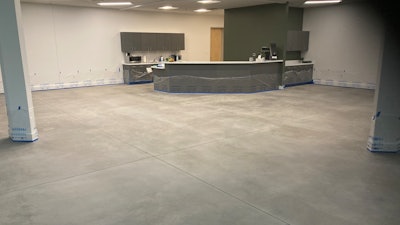 Coval Technologies
Coval Technologies
Step 2) What The Customer Wants & Requires
Step two is understanding what type of coating system the customer wants and requires. If they want a perfectly smooth flat coating, with all the chips, cracks and joints filled in like a piece of glass, is that something possible without major restoration? Is the floor covered in tile or carpet and will they want it stained with a transparent dye that won’t hide the imperfections such as the old tile grout lines or carpet glue lines? Understand if the coating system or finished look they are requesting and let them know if what they want is possible.
The steps needed to achieve the client’s expectations take experience. It is possible they don’t have the right concrete to meet their expectations and you must tell them that up front. For example, “Customer, your concrete will need resurfacing to get it flat before I can get the look you want.” Or, “I can stain it with the color you like but the grout lines from the old tile will still show in the finished floor.” “This old coating is blistering, which tells me your slab has moisture and will need a moisture vapor barrier installed.”
Step 3) The 'How To' Part
Step three is figuring out the prescription the concrete needs to successfully install the coating system that the customer has requested. This must also be clearly communicated to customers because once they find out the cost and complexity, they may change their mind. Don’t overlook any of the steps and time it will take to achieve the surface preparation requirements for the coating system you are installing.
A huge amount of information regarding concrete surface preparation is available on the internet. For example:
- Sherwin Williams produces excellent technical information. You will also find videos on shot blasting, concrete grinding and polishing, acid etching, and general surface preparation videos.
- The International Concrete Restoration Institute has webinars on coatings preparation.
- The Association for Materials Protection and Performance (AMPP, the combined organization of SSPC/NACE) has a wealth of information.
- Talk to the coatings manufacturer’s representative, distributors, other installers, and try to absorb knowledge like a sponge.
Learn how to use a floor maintainer and hand grinder and buy a good wet/dry vacuum and mop bucket. Before spending money on expensive equipment, become proficient with a floor maintainer and all the different attachments available for small job surface preparation. As you grow and expand, you can acquire shot blasters, concrete grinders, vacuums, and more expensive equipment.
Treat your concrete floors with the mind of a doctor and get them in perfectly clean healthy condition with the right prescription for your coating system. Surface preparation is 80% of the job on concrete and most types of floors. Applying the coating is a whole other topic.




![Fcp Racatac Chair 10893876[1]](https://img.forconstructionpros.com/mindful/acbm/workspaces/default/uploads/2025/10/fcp-racatac-chair-108938761.10l0At5WXv.png?auto=format%2Ccompress&bg=fff&fill-color=fff&fit=fill&h=100&q=70&w=100)

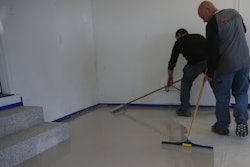
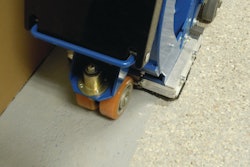




![Fcp Racatac Chair 10893876[1]](https://img.forconstructionpros.com/mindful/acbm/workspaces/default/uploads/2025/10/fcp-racatac-chair-108938761.10l0At5WXv.png?ar=16%3A9&auto=format%2Ccompress&bg=fff&fill-color=fff&fit=fill&h=135&q=70&w=240)

